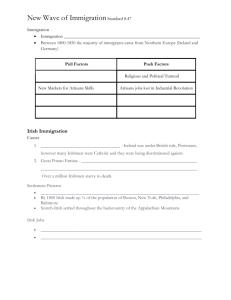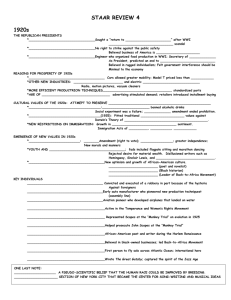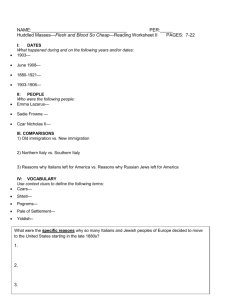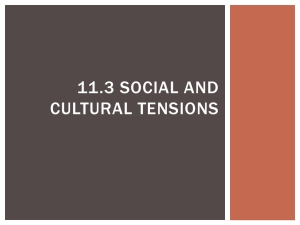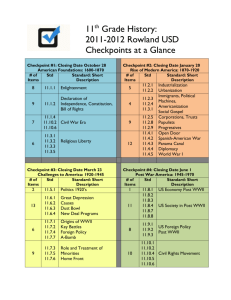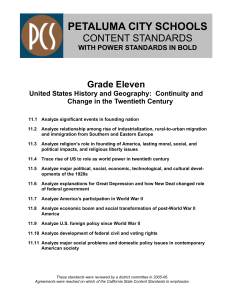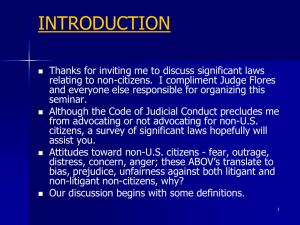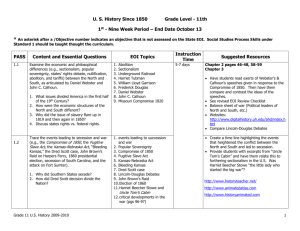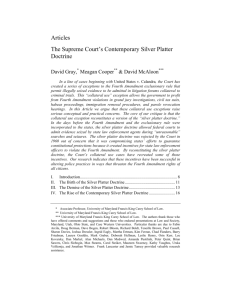founding of the nation & declaration of independence
advertisement
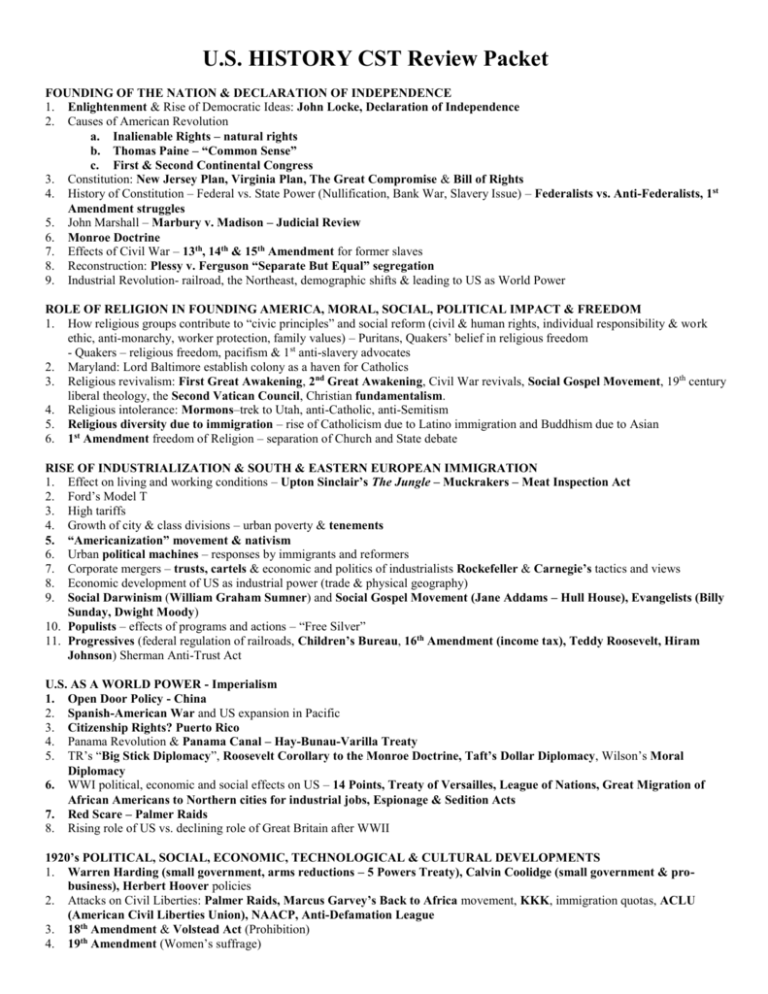
U.S. HISTORY CST Review Packet FOUNDING OF THE NATION & DECLARATION OF INDEPENDENCE 1. Enlightenment & Rise of Democratic Ideas: John Locke, Declaration of Independence 2. Causes of American Revolution a. Inalienable Rights – natural rights b. Thomas Paine – “Common Sense” c. First & Second Continental Congress 3. Constitution: New Jersey Plan, Virginia Plan, The Great Compromise & Bill of Rights 4. History of Constitution – Federal vs. State Power (Nullification, Bank War, Slavery Issue) – Federalists vs. Anti-Federalists, 1st Amendment struggles 5. John Marshall – Marbury v. Madison – Judicial Review 6. Monroe Doctrine 7. Effects of Civil War – 13th, 14th & 15th Amendment for former slaves 8. Reconstruction: Plessy v. Ferguson “Separate But Equal” segregation 9. Industrial Revolution- railroad, the Northeast, demographic shifts & leading to US as World Power ROLE OF RELIGION IN FOUNDING AMERICA, MORAL, SOCIAL, POLITICAL IMPACT & FREEDOM 1. How religious groups contribute to “civic principles” and social reform (civil & human rights, individual responsibility & work ethic, anti-monarchy, worker protection, family values) – Puritans, Quakers’ belief in religious freedom - Quakers – religious freedom, pacifism & 1st anti-slavery advocates 2. Maryland: Lord Baltimore establish colony as a haven for Catholics 3. Religious revivalism: First Great Awakening, 2nd Great Awakening, Civil War revivals, Social Gospel Movement, 19th century liberal theology, the Second Vatican Council, Christian fundamentalism. 4. Religious intolerance: Mormons–trek to Utah, anti-Catholic, anti-Semitism 5. Religious diversity due to immigration – rise of Catholicism due to Latino immigration and Buddhism due to Asian 6. 1st Amendment freedom of Religion – separation of Church and State debate RISE OF INDUSTRIALIZATION & SOUTH & EASTERN EUROPEAN IMMIGRATION 1. Effect on living and working conditions – Upton Sinclair’s The Jungle – Muckrakers – Meat Inspection Act 2. Ford’s Model T 3. High tariffs 4. Growth of city & class divisions – urban poverty & tenements 5. “Americanization” movement & nativism 6. Urban political machines – responses by immigrants and reformers 7. Corporate mergers – trusts, cartels & economic and politics of industrialists Rockefeller & Carnegie’s tactics and views 8. Economic development of US as industrial power (trade & physical geography) 9. Social Darwinism (William Graham Sumner) and Social Gospel Movement (Jane Addams – Hull House), Evangelists (Billy Sunday, Dwight Moody) 10. Populists – effects of programs and actions – “Free Silver” 11. Progressives (federal regulation of railroads, Children’s Bureau, 16th Amendment (income tax), Teddy Roosevelt, Hiram Johnson) Sherman Anti-Trust Act U.S. AS A WORLD POWER - Imperialism 1. Open Door Policy - China 2. Spanish-American War and US expansion in Pacific 3. Citizenship Rights? Puerto Rico 4. Panama Revolution & Panama Canal – Hay-Bunau-Varilla Treaty 5. TR’s “Big Stick Diplomacy”, Roosevelt Corollary to the Monroe Doctrine, Taft’s Dollar Diplomacy, Wilson’s Moral Diplomacy 6. WWI political, economic and social effects on US – 14 Points, Treaty of Versailles, League of Nations, Great Migration of African Americans to Northern cities for industrial jobs, Espionage & Sedition Acts 7. Red Scare – Palmer Raids 8. Rising role of US vs. declining role of Great Britain after WWII 1920’s POLITICAL, SOCIAL, ECONOMIC, TECHNOLOGICAL & CULTURAL DEVELOPMENTS 1. Warren Harding (small government, arms reductions – 5 Powers Treaty), Calvin Coolidge (small government & probusiness), Herbert Hoover policies 2. Attacks on Civil Liberties: Palmer Raids, Marcus Garvey’s Back to Africa movement, KKK, immigration quotas, ACLU (American Civil Liberties Union), NAACP, Anti-Defamation League 3. 18th Amendment & Volstead Act (Prohibition) 4. 19th Amendment (Women’s suffrage) U.S. HISTORY CST Review Packet 5. 6. 7. Harlem Renaissance: goals, Zora Neale Hurston & Langston Hughes Radio & Movies roll in the spread of popular culture Rise of mass production, growth of cities, new technologies (car & electricity) prosperity, rise of advertising GREAT DEPRESSION & NEW DEAL 1. Federal Reserve System & weakness of economy in 1920s 2. Stock Market Crash – creation of the SEC (Securities & Exchange Commission) 3. Causes of Depression & steps taken to combat it 4. Hoover’s Rugged Individualism, Reconstruction Finance Corporation – loans to banks and businesses 5. Effects of Depression: natural disasters, bad agricultural practices: Dust Bowl – Okies to California 6. New Deal: controversies- expanding of government in society and economy – decision to run for a 3rd and 4th term, Relief, Recovery & Reform (Bank Holiday, Civilian Conservation Corps, Works Progress Administration – Federal Writer’s Project, Social Security, National Labor Relations Board, TVA, California Central Valley Project, Bonneville Dam) 7. Organized Labor: advances and retreats, AFL American Federation of Labor (1886 Samuel Gompers), CIO Congress of Industrial Organization (John Lewis 1932), AFL-CIO (1955), United Farm Workers (Cesar Chavez) WWII 1. Neutrality Acts – Arsenal of Democracy – Economic embargo against Japan in 1930s 2. Causes of US involvement: Pearl Harbor (Dec. 7, 1941 – A date that will live in infamy) 3. US strategy: Battle of Midway, Normandy (D-Day), Iwo Jima, Okinawa, and Battle of the Bulge 4. American soldiers: Tuskegee Airmen (African Americans), 442nd Combat team (Japanese Americans), Navajo Codetalkers (Native Americans) 5. FDR’s foreign policies during war: Four Freedoms Speech 6. Home front: Japanese Interment – Korematsu v. United States, restrictions on German and Italian Americans, response to Holocaust, women in workforce, growing work and political demands of African Americans, War Production Board 7. Developments in aviation, weaponry, communication, & medicine & effect of war on industry – radar & sonar 8. Atomic bomb decision: Manhattan Project, Hiroshima & Nagasaki – Truman 9. Aid to Western Europe after war: Marshall Plan – economic recovery POST-WWII FOREIGN POLICY 1. United Nations, International Declaration of Human Rights, IMF, the World Bank, & GATT (General Agreement on Tariffs and Trade) 1947 – shaping modern Europe 2. Alliances: NATO, Warsaw Pact, and SEATO (Southeast Asia 1955-1971) during Cold War 3. Containment origin and consequences: a. McCarthyism- HUAC, Alger Hiss and Blacklisting b. Truman Doctrine – Containment – Greece & Turkey c. The Berlin Blockade d. The Korean War: Causes and results e. The Bay of Pigs Invasion, 1961 and Cuban Missile Crisis, 1962 f. Atomic testing in American west – “Mutual assured destruction”, massive retaliation, brinkmanship g. The Vietnam War: Gulf of Tonkin Resolution, Tet Offensive, War Powers Act h. Latin American Policy: Alliance for Progress 4. Effects of foreign policy on domestic policy: protests during Vietnam, “nuclear freeze” movement 5. Reagan Administration’s role in end of Cold War victory of West 6. U.S. Middle East policy – Gulf War 7. U.S. – Mexican relation in 20th Century – economic, political, immigration & economic. ECONOMIC BOOM & SOCIAL CHANGE POST WWII 1. Growth of service jobs, white collar, and professional sector 2. Mexican immigration impact – bracero program – agricultural economy in California 3. Taft-Hartley Act 1947, Truman’s labor policy & congressional reaction 4. Expanded federal government spending on defense, welfare, national debt, education spending (California Master Plan) 5. Increased power of president due to Great Depression, WWII & Cold War 6. Environmental regions in US – problems, economy, issues 7. Post-1945 technology and effects on society: computer revolution, communication changes, medicine. elimination of diseased like smallpox, agricultural technology 8. Popular Culture: jazz and other popular music, professional sports, architectural & artistic styles U.S. HISTORY CST Review Packet CIVIL RIGHTS & VOTING RIGHTS 1. Demands of African Americans lead to change: FDR’s ban of racial discrimination in defense industry, Truman’s desegregation of Armed Forces in 1948 2. Civil Rights Supreme Court Case: Dred Scott v Sandford, Plessy v. Ferguson, Brown v. Board of Education, UC Regents v. Bakke, California Prop 209 3. Black & white collaboration and legal strategy to fight segregation 4. Civil Rights leaders: A. Philip Randolph, Martin Luther King Jr., Malcolm X, Thurgood Marshall, James Farmer, Rosa Parks & MLK’s :Letter From a Birmingham Jail & I Have a Dream speech 5. Civil Rights events: role of churches, Little Rock Crisis – Little Rock 9, Birmingham - success lead to push for American Indian, Asian Americans, and Latinos for civil rights 6. Civil Rights Act of 1964, Voting Rights Act of 1965, 24 th Amendment 7. Women’s Rights Movement: Elizabeth Cady Stanton, Susan B. Anthony, 19th Amendment, feminism of 1960s and 1970s, Geraldine Ferraro 1984 VP Candidate CONTEMPORARY SOCIAL PROBLEMS & DOMESTIC POLICY ISSUES 1. Changing immigration policy: Immigration Act of 1965 – results more diversity especially from Latin America and Asia 2. Domestic policies (education, civil rights, economic policy, environmental) of Truman: Fair Deal – desegregation of the armed forces 3. Eisenhower: Prosperity, McCarthyism, 2 nd Red Scare. 4. Kennedy: Catholicism, New Frontier 5. Johnson: Great Society, War on Poverty, Immigration Act of 1965. Civil Rights Acts 6. Nixon: Silent Majority, Watergate 7. Carter: Human Rights, Energy Crisis, Iranian Hostage Crisis 8. Reagan: Reaganomics – tax breaks and deregulation, AIDS crisis, 9. Bush: Gulf War, Recession “Read my lips, no new taxes” 10. Clinton: Failure of healthcare, Monica Lewisky Scandal, NAFTA, Impeachment for perjury 11. Changing role of women in society: work & home – Geraldine Ferraro 1st VP Candidate in 1984 12. Watergate Scandal – constitutional crisis – Nixon resignation to avoid impeachment 13. Modern environmental movement: conflict between environmental protection advocates and private property advocates 14. Poverty, welfare reform, and health insurance issues 15. Demographic and social changes: move from “frostbelt” to Sun Belt, move to suburbs, minorities in inner-cities, decline of family farm, rise of out-of-wedlock births and drug abuse, rise of Catholicism






